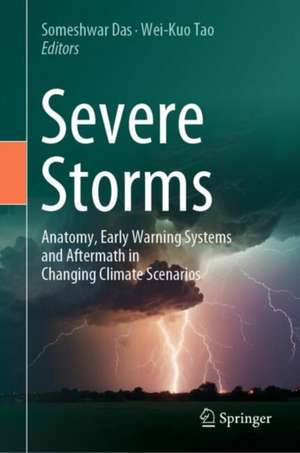Severe Storms: Anatomy, Early Warning Systems and Aftermath in Changing Climate Scenarios
Editat de Someshwar Das, Wei-Kuo Taoen Limba Engleză Hardback – 29 oct 2024
Preț: 1418.87 lei
Preț vechi: 1730.33 lei
-18% Nou
Puncte Express: 2128
Preț estimativ în valută:
271.50€ • 295.84$ • 228.78£
271.50€ • 295.84$ • 228.78£
Carte indisponibilă temporar
Doresc să fiu notificat când acest titlu va fi disponibil:
Se trimite...
Preluare comenzi: 021 569.72.76
Specificații
ISBN-13: 9789819770748
ISBN-10: 9819770742
Pagini: 800
Ilustrații: Approx. 800 p. 200 illus., 100 illus. in color.
Dimensiuni: 155 x 235 mm
Ediția:2025
Editura: Springer Nature Singapore
Colecția Springer
Locul publicării:Singapore, Singapore
ISBN-10: 9819770742
Pagini: 800
Ilustrații: Approx. 800 p. 200 illus., 100 illus. in color.
Dimensiuni: 155 x 235 mm
Ediția:2025
Editura: Springer Nature Singapore
Colecția Springer
Locul publicării:Singapore, Singapore
Cuprins
Chapter 1 Severe Storms Observed by Satellites.- Chapter 2 Satellite Observations of Severe Storms: Indian Perspectives.- Chapter 3 Structures of Severe Storms Observed by Dual Polarization Doppler.- Chapter 4 Detection of Severe Storms by Doppler Weather Radar.- Chapter 5 Weather Radar Networks and Their Use in Monitoring Severe Storms in the Northeast Indian Subcontinent: Status and Expectations.- Chapter 6 Cloud Microphysical Parameters Observed in Convective Clouds.- Chapter 7 Thunderstorm Electrification and Lightnings Over the Indian.- Chapter 8 Raindrop Size Distributions of Indo-Pacific Tropical Cyclones and their Hydro-meteorological Implications.- Chapter 9 Analysis and Numerical Modelling of Linear-Shaped Mesoscale Convective Systems.- Chapter 10 Modelling Hail Microphysical Processes in Severe.- Chapter 11 Observation and Simulation of Severe.- Chapter 12 Wind Characteristics Associated with Turbulence in the Atmospheric Boundary Layer during Severe Storms.- Chapter 13 Dynamics of Rainstorms over Southern Himalayan Slopes & Foothills and their Simulations by the Model.- Chapter 14 Physical and Dynamic Characteristics of Severe Storms: Bangladesh Perspective.- Chapter 15 Assimilation of Surface Mesonet Observations and Ground-based Radar and Lidar Data for Improved Prediction of Mesoscale Convective.- Chapter 16 Rapid Update Cycle Data Assimilation for Severe Storm Prediction.- Chapter 17 Ensemble Forecasting of Severe Storms Over.- Chapter 18 Lightning Forecasting and Utilization of AI/ ML in Early Warnings.- Chapter 19 Severe Storms Forecasting and Forecast Demonstration Project Over the IndianRegion.- Chapter 20 How Long Could Winter Storms Last? Cold-Season Event-Based Extreme Precipitation Statistics Over the Conterminous U.S..- Chapter 21 Climate Change and Monsoon Rainstorms.- Chapter 22 Severe Storms in Changing Climate Scenario with a Distinctive Emphasis on South Asia and India.- Chapter 23 Historical Trend and Future Projection of Extreme Precipitation in Nepal from High-Resolution CMIP6 Data.- Chapter 24 Socio-Economic Implications of Severe Storms in the Changing Climatic Scenarios: A Case of South Asia.- Chapter 25 Disaster Risk Reduction Policies in the Aftermath of Severe Storms for Asia and the Pacific Region.- Chapter 26 Epilogue.
Notă biografică
Prof. Someshwar Das is Secretary of the South Asian Meteorological Association (SAMA) and its Founding Member. He is founding President of the Indian Meteorological Society (Jaipur Chapter). He is founding Chair Professor of the Department of Atmospheric Science, Central University of Rajasthan, India. He worked as Senior Scientist (Scientist-G) at the National Centre for Medium Range Weather Forecasting (NCMRWF). He played a key role in the SAARC STORM project and capacity building of the people of South Asia in the area of Numerical Weather Prediction (NWP). His areas of interests are cumulus convection, cloud microphysics, global and mesoscale modelling, and high-impact severe weather forecasting. Prof. Das received his Ph.D. (Atmospheric Science) from the Indian Institute of Technology, Delhi, in 1987 and M.Sc. (Meteorology) from Andhra University, Waltair, India.
Dr. Wei-Kuo Tao is an Emeritus Scientist at the NASA Goddard Space Flight Center, USA. He is a Chair Professor at the National Central University in Taiwan. His research interests include cloud-precipitation physics and modelling mesoscale convective systems. He was the leader of the Goddard Mesoscale Modeling and Dynamics Group. He holds a M.S. and a Doctorate degree in Atmospheric Sciences from the University of Illinois. He also holds a M.S. in Computer Science from the Johns Hopkins University. Dr. Tao is Fellow of American Geophysical Union, American Meteorological Society, Royal Meteorological Society and Chinese Meteorological Society (Taiwan).
Dr. Wei-Kuo Tao is an Emeritus Scientist at the NASA Goddard Space Flight Center, USA. He is a Chair Professor at the National Central University in Taiwan. His research interests include cloud-precipitation physics and modelling mesoscale convective systems. He was the leader of the Goddard Mesoscale Modeling and Dynamics Group. He holds a M.S. and a Doctorate degree in Atmospheric Sciences from the University of Illinois. He also holds a M.S. in Computer Science from the Johns Hopkins University. Dr. Tao is Fellow of American Geophysical Union, American Meteorological Society, Royal Meteorological Society and Chinese Meteorological Society (Taiwan).
Textul de pe ultima copertă
The book provides information on the observational aspects of the severe storms through satellite, radar, aircraft, and ground based network of stations and these issues are discussed in the first part of the book consisting of 8 chapters. The numerical modelling and data assimilation techniques are discussed in the second part of the book aimed at development of Early Warning Systems (12 chapters) and finally the outlook of the severe storms in a changing climate scenario, their socio-economic impacts and policies for disaster mitigation are discussed in the third part of the book consisting of 6 chapters. This book is of great interest to atmospheric scientists and other researchers, practitioners, policy and decision makers, international institutions, governmental and non-governmental organizations, educators, as well as students.
Caracteristici
Describes observational aspects of severe storms through satellite, radar, and ground-based network of stations Includes the numerical modelling and data assimilation techniques aimed at development of Early Warning Systems Discusses socio-economic impacts of severe storms in the changing climate scenarios and policies for disaster mitigation
